engine overheat INFINITI Q50 2019 User Guide
[x] Cancel search | Manufacturer: INFINITI, Model Year: 2019, Model line: Q50, Model: INFINITI Q50 2019Pages: 468, PDF Size: 2.15 MB
Page 346 of 468
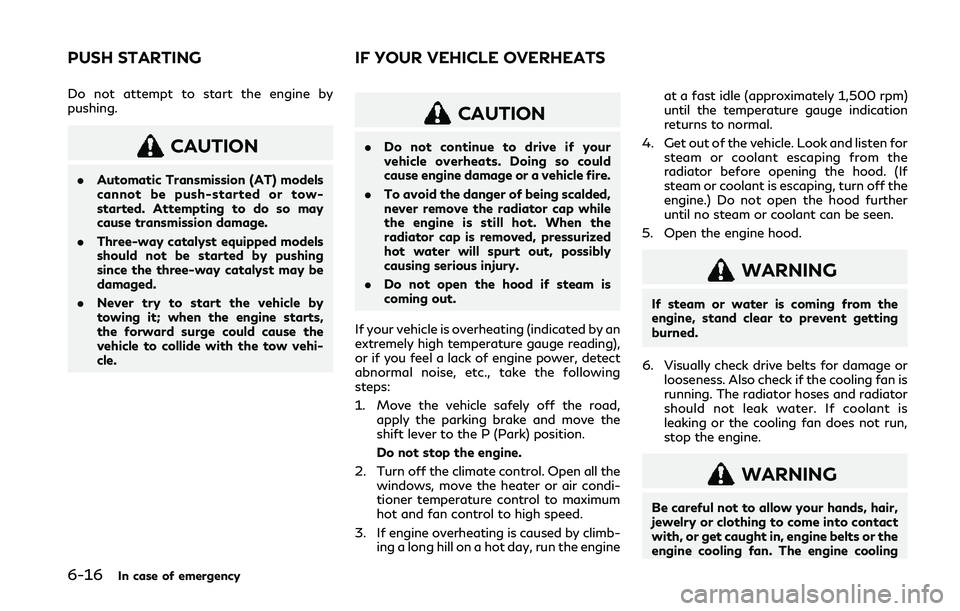
6-16In case of emergency
Do not attempt to start the engine by
pushing.
CAUTION
.Automatic Transmission (AT) models
cannot be push-started or tow-
started. Attempting to do so may
cause transmission damage.
. Three-way catalyst equipped models
should not be started by pushing
since the three-way catalyst may be
damaged.
. Never try to start the vehicle by
towing it; when the engine starts,
the forward surge could cause the
vehicle to collide with the tow vehi-
cle.
CAUTION
.Do not continue to drive if your
vehicle overheats. Doing so could
cause engine damage or a vehicle fire.
. To avoid the danger of being scalded,
never remove the radiator cap while
the engine is still hot. When the
radiator cap is removed, pressurized
hot water will spurt out, possibly
causing serious injury.
. Do not open the hood if steam is
coming out.
If your vehicle is overheating (indicated by an
extremely high temperature gauge reading),
or if you feel a lack of engine power, detect
abnormal noise, etc., take the following
steps:
1. Move the vehicle safely off the road, apply the parking brake and move the
shift lever to the P (Park) position.
Do not stop the engine.
2. Turn off the climate control. Open all the windows, move the heater or air condi-
tioner temperature control to maximum
hot and fan control to high speed.
3. If engine overheating is caused by climb- ing a long hill on a hot day, run the engine at a fast idle (approximately 1,500 rpm)
until the temperature gauge indication
returns to normal.
4. Get out of the vehicle. Look and listen for steam or coolant escaping from the
radiator before opening the hood. (If
steam or coolant is escaping, turn off the
engine.) Do not open the hood further
until no steam or coolant can be seen.
5. Open the engine hood.
WARNING
If steam or water is coming from the
engine, stand clear to prevent getting
burned.
6. Visually check drive belts for damage or looseness. Also check if the cooling fan is
running. The radiator hoses and radiator
should not leak water. If coolant is
leaking or the cooling fan does not run,
stop the engine.
WARNING
Be careful not to allow your hands, hair,
jewelry or clothing to come into contact
with, or get caught in, engine belts or the
engine cooling fan. The engine cooling
PUSH STARTING IF YOUR VEHICLE OVERHEATS
Page 364 of 468
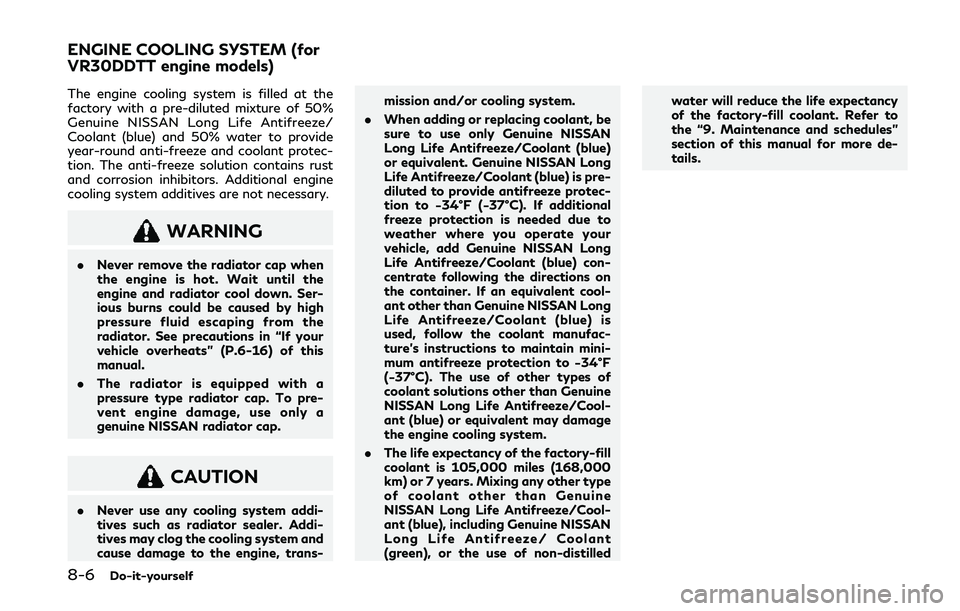
8-6Do-it-yourself
The engine cooling system is filled at the
factory with a pre-diluted mixture of 50%
Genuine NISSAN Long Life Antifreeze/
Coolant (blue) and 50% water to provide
year-round anti-freeze and coolant protec-
tion. The anti-freeze solution contains rust
and corrosion inhibitors. Additional engine
cooling system additives are not necessary.
WARNING
.Never remove the radiator cap when
the engine is hot. Wait until the
engine and radiator cool down. Ser-
ious burns could be caused by high
pressure fluid escaping from the
radiator. See precautions in “If your
vehicle overheats” (P.6-16) of this
manual.
. The radiator is equipped with a
pressure type radiator cap. To pre-
vent engine damage, use only a
genuine NISSAN radiator cap.
CAUTION
.Never use any cooling system addi-
tives such as radiator sealer. Addi-
tives may clog the cooling system and
cause damage to the engine, trans- mission and/or cooling system.
. When adding or replacing coolant, be
sure to use only Genuine NISSAN
Long Life Antifreeze/Coolant (blue)
or equivalent. Genuine NISSAN Long
Life Antifreeze/Coolant (blue) is pre-
diluted to provide antifreeze protec-
tion to −34°F (−37°C). If additional
freeze protection is needed due to
weather where you operate your
vehicle, add Genuine NISSAN Long
Life Antifreeze/Coolant (blue) con-
centrate following the directions on
the container. If an equivalent cool-
ant other than Genuine NISSAN Long
Life Antifreeze/Coolant (blue) is
used, follow the coolant manufac-
ture’s instructions to maintain mini-
mum antifreeze protection to −34°F
(−37°C). The use of other types of
coolant solutions other than Genuine
NISSAN Long Life Antifreeze/Cool-
ant (blue) or equivalent may damage
the engine cooling system.
. The life expectancy of the factory-fill
coolant is 105,000 miles (168,000
km) or 7 years. Mixing any other type
of coolant other than Genuine
NISSAN Long Life Antifreeze/Cool-
ant (blue), including Genuine NISSAN
Long Life Antifreeze/ Coolant
(green), or the use of non-distilled water will reduce the life expectancy
of the factory-fill coolant. Refer to
the “9. Maintenance and schedules”
section of this manual for more de-
tails.
ENGINE COOLING SYSTEM (for
VR30DDTT engine models)
Page 365 of 468
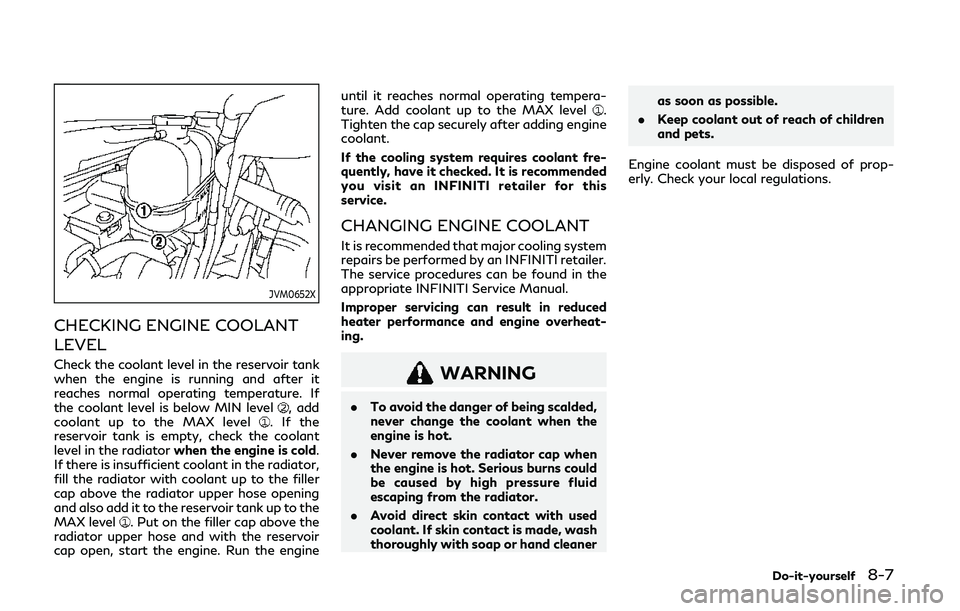
JVM0652X
CHECKING ENGINE COOLANT
LEVEL
Check the coolant level in the reservoir tank
when the engine is running and after it
reaches normal operating temperature. If
the coolant level is below MIN level
, add
coolant up to the MAX level. If the
reservoir tank is empty, check the coolant
level in the radiator when the engine is cold.
If there is insufficient coolant in the radiator,
fill the radiator with coolant up to the filler
cap above the radiator upper hose opening
and also add it to the reservoir tank up to the
MAX level
. Put on the filler cap above the
radiator upper hose and with the reservoir
cap open, start the engine. Run the engine until it reaches normal operating tempera-
ture. Add coolant up to the MAX level
.
Tighten the cap securely after adding engine
coolant.
If the cooling system requires coolant fre-
quently, have it checked. It is recommended
you visit an INFINITI retailer for this
service.
CHANGING ENGINE COOLANT
It is recommended that major cooling system
repairs be performed by an INFINITI retailer.
The service procedures can be found in the
appropriate INFINITI Service Manual.
Improper servicing can result in reduced
heater performance and engine overheat-
ing.
WARNING
. To avoid the danger of being scalded,
never change the coolant when the
engine is hot.
. Never remove the radiator cap when
the engine is hot. Serious burns could
be caused by high pressure fluid
escaping from the radiator.
. Avoid direct skin contact with used
coolant. If skin contact is made, wash
thoroughly with soap or hand cleaner as soon as possible.
. Keep coolant out of reach of children
and pets.
Engine coolant must be disposed of prop-
erly. Check your local regulations.
Do-it-yourself8-7
Page 366 of 468
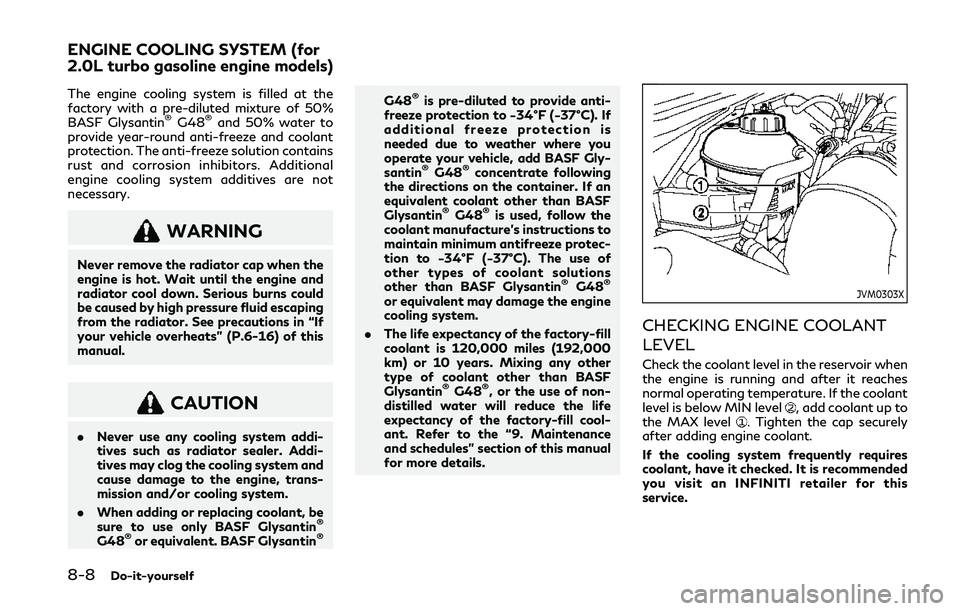
8-8Do-it-yourself
The engine cooling system is filled at the
factory with a pre-diluted mixture of 50%
BASF Glysantin
®G48®and 50% water to
provide year-round anti-freeze and coolant
protection. The anti-freeze solution contains
rust and corrosion inhibitors. Additional
engine cooling system additives are not
necessary.
WARNING
Never remove the radiator cap when the
engine is hot. Wait until the engine and
radiator cool down. Serious burns could
be caused by high pressure fluid escaping
from the radiator. See precautions in “If
your vehicle overheats” (P.6-16) of this
manual.
CAUTION
. Never use any cooling system addi-
tives such as radiator sealer. Addi-
tives may clog the cooling system and
cause damage to the engine, trans-
mission and/or cooling system.
. When adding or replacing coolant, be
sure to use only BASF Glysantin
®
G48®or equivalent. BASF Glysantin®
G48®is pre-diluted to provide anti-
freeze protection to −34°F (−37°C). If
additional freeze protection is
needed due to weather where you
operate your vehicle, add BASF Gly-
santin
®G48®concentrate following
the directions on the container. If an
equivalent coolant other than BASF
Glysantin
®G48®is used, follow the
coolant manufacture’s instructions to
maintain minimum antifreeze protec-
tion to −34°F (−37°C). The use of
other types of coolant solutions
other than BASF Glysantin
®G48®
or equivalent may damage the engine
cooling system.
. The life expectancy of the factory-fill
coolant is 120,000 miles (192,000
km) or 10 years. Mixing any other
type of coolant other than BASF
Glysantin
®G48®, or the use of non-
distilled water will reduce the life
expectancy of the factory-fill cool-
ant. Refer to the “9. Maintenance
and schedules” section of this manual
for more details.
JVM0303X
CHECKING ENGINE COOLANT
LEVEL
Check the coolant level in the reservoir when
the engine is running and after it reaches
normal operating temperature. If the coolant
level is below MIN level
, add coolant up to
the MAX level. Tighten the cap securely
after adding engine coolant.
If the cooling system frequently requires
coolant, have it checked. It is recommended
you visit an INFINITI retailer for this
service.
ENGINE COOLING SYSTEM (for
2.0L turbo gasoline engine models)
Page 367 of 468

CHANGING ENGINE COOLANT
It is recommended that major cooling system
repairs be performed by an INFINITI retailer.
The service procedures can be found in the
appropriate INFINITI Service Manual.
Improper servicing can result in reduced
heater performance and engine overheat-
ing.
WARNING
.To avoid the danger of being scalded,
never change the coolant when the
engine is hot.
. Never remove the radiator cap when
the engine is hot. Serious burns could
be caused by high pressure fluid
escaping from the radiator.
. Avoid direct skin contact with used
coolant. If skin contact is made, wash
thoroughly with soap or hand cleaner
as soon as possible.
. Keep coolant out of reach of children
and pets.
Engine coolant must be disposed of prop-
erly. Check your local regulations. The intercooler cooling system is filled at the
factory with a pre-diluted mixture of 50%
Genuine NISSAN Long Life Antifreeze/
Coolant (blue) and 50% water to provide
year-round anti-freeze and coolant protec-
tion. The antifreeze solution contains rust
and corrosion inhibitors. Additional inter-
cooler cooling system additives are not
necessary.
WARNING
.
Never remove the coolant reservoir
cap when the engine is hot. Wait until
the engine cools down. Serious burns
could be caused by high pressure fluid
escaping from the coolant reservoir.
. The intercooler reservoir is equipped
with a pressure type cap. To prevent
engine and intercooler damage, use
only a genuine NISSAN intercooler
reservoir cap.
CAUTION
.Never use any additives in the cool-
ant such as radiator sealer in the
cooling system. This may cause da-
mage to the intercooler. .
When adding or replacing coolant, be
sure to use only Genuine NISSAN
Long Life Antifreeze/Coolant (blue)
or equivalent. Genuine NISSAN Long
Life Antifreeze/Coolant (blue) is pre-
diluted to provide antifreeze protec-
tion to −34°F(−37°C). If additional
freeze protection is needed due to
weather where you operate your
vehicle, add Genuine NISSAN Long
Life Antifreeze/Coolant (blue) con-
centrate following the directions on
the container. If an equivalent cool-
ant other than Genuine NISSAN Long
Life Antifreeze/Coolant (blue) is
used, follow the coolant manufac-
ture’s instructions to maintain mini-
mum antifreeze protection to −34°F
(−37°C). The use of other types of
coolant solutions other than Genuine
NISSAN Long Life Antifreeze/Cool-
ant (blue) or equivalent may damage
the Intercooler cooling system.
Do-it-yourself8-9
INTERCOOLER COOLING SYSTEM
(for VR30DDTT engine models)
Page 368 of 468
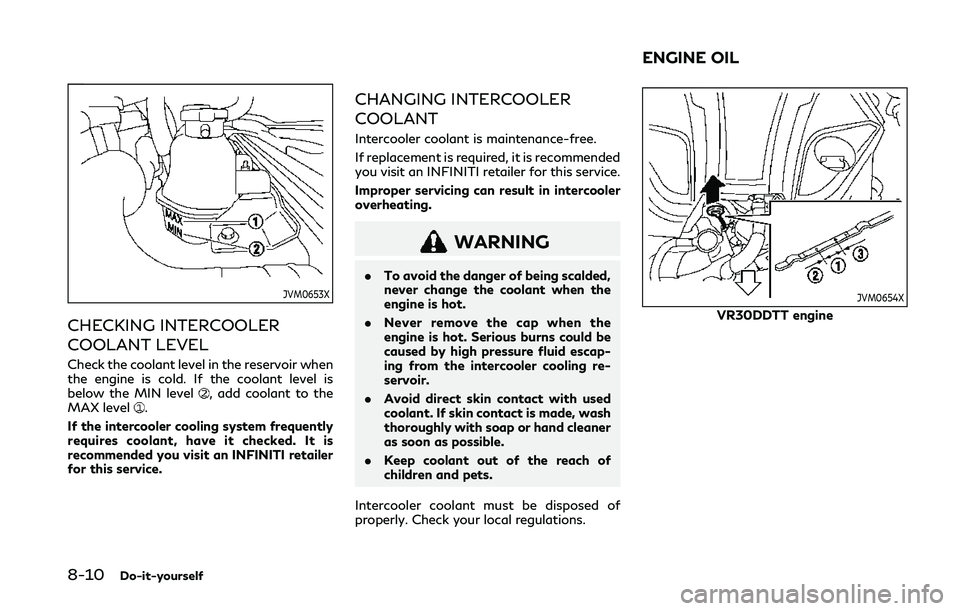
8-10Do-it-yourself
JVM0653X
CHECKING INTERCOOLER
COOLANT LEVEL
Check the coolant level in the reservoir when
the engine is cold. If the coolant level is
below the MIN level
, add coolant to the
MAX level.
If the intercooler cooling system frequently
requires coolant, have it checked. It is
recommended you visit an INFINITI retailer
for this service.
CHANGING INTERCOOLER
COOLANT
Intercooler coolant is maintenance-free.
If replacement is required, it is recommended
you visit an INFINITI retailer for this service.
Improper servicing can result in intercooler
overheating.
WARNING
. To avoid the danger of being scalded,
never change the coolant when the
engine is hot.
. Never remove the cap when the
engine is hot. Serious burns could be
caused by high pressure fluid escap-
ing from the intercooler cooling re-
servoir.
. Avoid direct skin contact with used
coolant. If skin contact is made, wash
thoroughly with soap or hand cleaner
as soon as possible.
. Keep coolant out of the reach of
children and pets.
Intercooler coolant must be disposed of
properly. Check your local regulations.
JVM0654X
VR30DDTT engine
ENGINE OIL
Page 430 of 468

10-6Technical and consumer information
sible.
Incorrect ignition timing will result in knock-
ing, after-run or overheating. This in turn
may cause excessive fuel consumption or
damage to the engine. If any of the above
symptoms are encountered, have your ve-
hicle checked. It is recommended you visit an
INFINITI retailer for servicing.
However, now and then you may notice
light spark knock for a short time while
accelerating or driving up hills. This is no
cause for concern, because you get the
greatest fuel benefit when there is light
spark knock for a short time under heavy
engine load.
FUEL INFORMATION (for 2.0L
turbo gasoline engine model)
Use unleaded premium gasoline with an
octane rating of at least 91 AKI (Anti-Knock
Index) number (Research octane number 96).
If unleaded premium gasoline is not avail-
able, unleaded regular gasoline with an
octane rating of at least 87 AKI number
(Research octane number 91) may be tem-
porarily used, but only under the following
precautions:
.Have the fuel tank filled only partially
with unleaded regular gasoline, and fill
up with unleaded premium gasoline as
soon as possible. .
Avoid full throttle driving and abrupt
acceleration.
Use unleaded premium gasoline for max-
imum vehicle performance.
CAUTION
. Using a fuel other than that specified
could adversely affect the emission
control system, and may also affect
warranty coverage.
. Under no circumstances should a
leaded gasoline be used, because this
will damage the three-way catalyst.
. Do not use E-15 or E-85 fuel in your
vehicle. Your vehicle is not designed
to run on E-15 or E-85 fuel. Using E-
15 or E-85 fuel in a vehicle not
specifically designed for E-15 or E-
85 fuel can adversely affect the
emission control devices and systems
of the vehicle. Damage caused by
such fuel is not covered by the
INFINITI new vehicle limited war-
ranty.
. Do not use fuel that contains the
octane booster methylcyclopentadie-
nyl manganese tricarbonyl (MMT).
Using fuel containing MMT may
adversely affect vehicle performance and vehicle emissions. Not all fuel
dispensers are labeled to indicate
MMT content, so you may have to
consult your gasoline retailer for
more details. Note that Federal and
California laws prohibit the use of
MMT in reformulated gasoline.
. U.S. government regulations require
ethanol dispensing pumps to be iden-
tified by a small, square, orange and
black label with the common abbre-
viation or the appropriate percen-
tage for that region.
Gasoline specifications
INFINITI recommends using gasoline that
meets the World-Wide Fuel Charter
(WWFC) specifications where it is available.
Many of the automobile manufacturers
developed this specification to improve
emission system and vehicle performance.
Ask your service station manager if the
gasoline meets the World-Wide Fuel Char-
ter (WWFC) specifications.
Reformulated gasoline
Some fuel suppliers are now producing
reformulated gasolines. These gasolines are
specially designed to reduce vehicle emis-
sions. INFINITI supports efforts towards
cleaner air and suggests that you use
Page 432 of 468

10-8Technical and consumer information
that can be harmful to the fuel system and
engine.
Octane rating tips
Using unleaded gasoline with an octane
rating lower than recommended above can
cause persistent, heavy spark knock. (Spark
knock is a metallic rapping noise.) If severe,
this can lead to engine damage. If you
detect a persistent heavy spark knock even
when using gasoline of the stated octane
rating, or if you hear steady spark knock
while holding a steady speed on level roads,
it is recommended you have an INFINITI
retailer correct the condition. Failure to
correct the condition is misuse of the
vehicle, for which INFINITI is not respon-
sible.
Incorrect ignition timing will result in knock-
ing, after-run or overheating. This in turn
may cause excessive fuel consumption or
damage to the engine. If any of the above
symptoms are encountered, have your ve-
hicle checked. It is recommended you visit an
INFINITI retailer for servicing.
However, now and then you may notice
light spark knock for a short time while
accelerating or driving up hills. This is no
cause for concern, because you get the
greatest fuel benefit when there is light
spark knock for a short time under heavy
engine load.
JVT0342X
API certification mark
API service symbol
ENGINE OIL AND OIL FILTER
RECOMMENDATION
VR30DDTT engine model
Selecting the correct oil:
It is essential to choose the correct grade,
quality, and viscosity engine oil to ensure
satisfactory engine life and performance,
see “Capacities and recommended fluids/
lubricants” (P.10-2). INFINITI recommends
the use of an energy conserving oil in order
to improve fuel economy.Select only engine oils that meet the Amer-
ican Petroleum Institute (API) certification
or International Lubricant Standardization
and Approval Committee (ILSAC) certifica-
tion and SAE viscosity standard. These oils
have the API certification mark on the front
of the container. Oils which do not have the
specified quality label should not be used as
they could cause engine damage.
Oil additives:
INFINITI does not recommend the use of oil
additives. The use of an oil additive is not
necessary when the proper oil type is used
and maintenance intervals are followed.
Oil which may contain foreign matter or has
been previously used should not be used.
Page 454 of 468

11-2
Cold weather driving ........................................ 5-142
Compact spare tire ............................................. 8-45
Console box ........................................................... 2-49
CoolantCapacities and
recommended fluids/lubricants ................. 10-2
Changing engine coolant ...................... 8-7, 8-9
Checking engine coolant level ............. 8-7, 8-8
Corrosion protection ............................................. 7-7
Courtesy light ....................................................... 2-58
Cruise control ....................................................... 5-72 Fixed speed cruise control (on
ICC system) ..................................................... 5-91
Intelligent Cruise Control (ICC) ................. 5-74
Cruise indicator .................................................... 2-23
Cup holders ........................................................... 2-46
Current fuel consumption ................................. 2-28
D
Daytime running light system .......................... 2-40
Defroster switch
Rear window and outside mirror
defroster switch ............................................. 2-35
Dimensions .......................................................... 10-13
Direct Adaptive Steering ................................. 5-129
Distance Control Assist (DCA) ........................ 5-95
Distance to empty ............................................... 2-27
Drive belts .............................................................. 8-19
Drive positioner .................................................... 3-33
Driver assist system indicator .......................... 2-24 Driving
Cold weather driving ................................. 5-142
Driving with automatic transmission ....... 5-16
Precautions when starting and driving ..... 5-4
E
ECO drive indicator light ................................... 2-16
ECO mode ............................................................. 5-23
ECO pedal system ............................................... 5-23
Economy Fuel ................................................................. 5-124
Elapsed time ......................................................... 2-27
Elapsed time and trip odometer ..................... 2-27
Emission control information label ............... 10-16
Emission control system maintenance ............ 9-8
Emission control system warranty .............. 10-23
Engine Before starting the engine .......................... 5-14
Break-in schedule ........................................ 5-123
Capacities and
recommended fluids/lubricants ................. 10-2
Changing engine coolant ...................... 8-7, 8-9
Changing engine oil and filter .................... 8-11
Checking engine coolant level ............. 8-7, 8-8
Checking engine oil level ............................. 8-11
Coolant temperature gauge ......................... 2-8
Emergency engine shut off ......................... 5-13
Engine block heater ................................... 5-143
Engine compartment check locations ........ 8-4
Engine cooling system ................................... 8-6
Engine oil ........................................................ 8-10 Engine oil and filter
replacement indicator ................................... 2-25
Engine oil and oil
filter recommendation ................................. 10-8
Engine serial number ................................. 10-15
Engine specifications .................................. 10-11
Engine start operation indicator ............... 2-21
If your vehicle overheats ............................. 6-16
Remote engine start .................................... 3-20
Remote engine start
operation indicator ........................................ 2-21
Starting the engine ....................................... 5-15
Engine coolant temperature gauge .................. 2-8
Entry/exit function Automatic drive positioner ......................... 3-33
Event Data Recorders (EDR) ........................ 10-26
Exhaust gas (carbon monoxide) ........................ 5-4
Explanation of scheduled
maintenance items ................................................. 9-5
F
F.M.V.S.S./C.M.V.S.S. certification label .... 10-15
Filter Air cleaner housing filter ............................. 8-21
Changing engine oil and filter .................... 8-11
Flashers (See hazard warning
flasher switch) ......................................................... 6-2
Flat tire ...................................................................... 6-3
Flat Tire - Visit dealer warning ....................... 2-22
Flat towing ......................................................... 10-22
Floor mat cleaning ................................................. 7-5
Page 457 of 468

Under the hood and vehicle ......................... 9-4
Maintenance schedules ........................................ 9-6
Malfunction indicator light (MIL) ..................... 2-17
Map lights .............................................................. 2-55
Master warning light .......................................... 2-14
Mechanical key (Intelligent Key system) .......... 3-3
Memory storage Automatic drive positioner ......................... 3-34
Meter Trip computer ................................................. 2-27
Meters and gauges ................................................ 2-6 Instrument brightness control ................... 2-41
Mirror
Inside mirror ................................................... 3-30
Outside mirrors .............................................. 3-31
Vanity mirror ................................................... 3-33
Moonroof ............................................................... 2-53
N
NAVI Shift Control .............................................. 5-20
New vehicle break-in ........................................ 5-123
O
Odometer .................................................................. 2-7
Off-road recovery .................................................. 5-9
Oil Capacities and
recommended fluids/lubricants ................. 10-2
Changing engine oil and filter .................... 8-11
Checking engine oil level ............................. 8-11 Engine oil ........................................................ 8-10
One touch unlock sensor (See Intelligent
Key system) ........................................................... 3-10
Operation Indicators for operation ............................... 2-21
Outside air temperature .................................... 2-29
Outside mirrors .................................................... 3-31
Overheat, If your vehicle overheats ............... 6-16
Owner’s Manual/Service Manual
order information ............................................. 10-26
P
Panic alarm ............................................................ 3-18
Parking Parking brake operation .............................. 5-21
Parking on hills ............................................. 5-127
Parking brake break-in .................................... 5-131
Personal lights ...................................................... 2-56
PERSONAL mode ............................................... 5-25
Phone Car phone or CB radio ................................... 4-4
Power Power door lock ............................................... 3-4
Power outlet ................................................... 2-45
Power steering fluid ..................................... 8-14
Power steering system ............................. 5-128
Power windows ............................................. 2-51
Power moonroof ................................................. 2-53
Power steering warning light ........................... 2-14
Precautions Braking precautions .................................... 5-131 Child restraints ............................................... 1-24
Cruise control ................................................. 5-72
Maintenance ..................................................... 8-3
Seat belt usage .............................................. 1-12
Supplemental restraint system .................. 1-42
When starting and driving ............................ 5-4
Pre-crash seat belts with
comfort function .................................................. 1-14
Predictive Forward Collision
Warning (PFCW) ............................................... 5-114
Push starting ......................................................... 6-16
Push-button ignition switch .............................. 5-11R
Radio
Car phone or CB radio ................................... 4-4
Rain-sensing auto wiper system ..................... 2-34
Rapid air pressure loss .......................................... 5-9
Readiness for inspection/maintenance
(I/M) test (US only) .......................................... 10-25
Rear door lock
Child safety rear door lock ........................... 3-6
Rear seats ................................................................. 1-5
Rear window and outside mirror
defroster switch ................................................... 2-35
Recorders Event data .................................................... 10-26
Registering your vehicle in
another country ................................................ 10-14
Remote engine start ........................................... 3-20
Remote keyless entry system .......................... 3-16
11-5